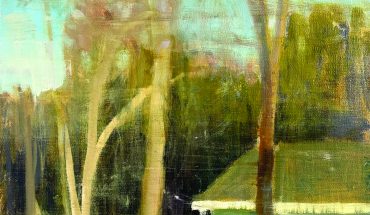
Lowe’s Pavilion at the NCMA
Architectural jewels across the Triangle
by J. Michael Welton
It happens every day at the 160-acre park on the campus of the North Carolina Museum of Art: Three minimalist structures deliver joy and wonder to hundreds of joggers, bikers, and meanderers visiting the site. They’re diversions in the landscape, placed to punctuate and celebrate the visual richness of the grounds. But they’re not only meant to be seen – they also provide a vantage point to better appreciate the beauty of their own surroundings.
Two of these structures can be considered pure architectural follies – diminutive, decorative objects placed in the park without an obvious purpose. One is the Lowe’s Pavilion, designed by Tonic Design and Mike Cindric. Sure, it’s sometimes used as a classroom, and it does have a storage component – but mostly it’s a gathering spot designed to direct the eye out to an open, western landscape.
Created with a $50,000 grant from Lowe’s Home Improvement, the pavilion covers a total of 800 square feet, with a perforated metal skin as transparent as a cicada’s wing. It was fabricated in a metal shop and assembled on-site in 2007; today, it’s a light-shifting setting for yoga exercises, wedding photography, and even the occasional nuptials. It’s a folly, yes – but a serious one, and well-loved.
Down the hill, overlooking a pond that cleans and filters storm water before releasing it to a stream below, is a platform created out of steel, poured-in-place concrete, and South American ipe wood. It hovers over the water’s edge, creating a place for rest and contemplation – and for conversations about sustainability in the environment. It was created by students at N.C. State’s Design/Build summer program in 2013 – and ever since it’s been a gaze-shifter, conversation-starter, and a fixture that’s fully part of the pond.
Back up the hill, tucked into the woods in an area called the Discovery Garden, lies the newest addition by N.C. State students – a small structure with a pair of purposes. It’s a storage shed for tools used by volunteers, its design clearly influenced by the mid-century modernism that’s part of Raleigh’s DNA. Built of steel and pine – charred and sealed in the Japanese shou-sugi-ban method – it was completed this past summer. It’s a playful and lighthearted space with an extended canopy that provides shelter from a storm. Because of its functional aspects, it can’t be considered a true folly, but it can be considered a Zen-like center of calm.
The NCMA park is not the area’s only notable public landscape that features small decorative structures. At Duke University’s Sarah P. Duke Gardens Charlotte Brody Discovery Garden, architect Ellen Cassilly’s elliptical pavilion provides visual interest. It features a base of stone and concrete and a metal trellis that weaves its oval way to a Pantheon-like oculus at the center of its roof. In one imaginative gesture, Cassilly introduced trumpet and cross vines to the winding rebar; when it all climbs to the top, the oculus is trimmed to allow sunlight in.
A new prairie garden, also at Duke, also features a striking folly by Cassilly. It’s a rectangular structure on a hillside, topped with a sloped roof. Thousands of seeds native to North Carolina’s prairies planted on the hillside have resulted in grasses that now rise three feet up to partially hide this ephemeral vision. On its sides, Cassilly designed woven, thin, debarked cedar trees between pine timbers, yielding what may be her finest and most fetching small building to date. “It’s an orientation device,” she says. “When it’s hot, you see this shady spot up the hill, and it calls you up.”

Old Well near the former site of Wake Forest College
Out in Wake Forest, tradition rules when it comes to architectural follies. At the Wake Forest Historical Museum, adjacent to the Calvin Jones House (circa 1820), rests the Old Well from the former site of Wake Forest College. At its center is a sculptural, Beaux-Arts marble fountain donated by the class of 1911, long before the college moved to Winston-Salem in 1956. Its classical gazebo was designed by New York architect Frank E. Perkins in 1934. No longer a functioning well, it’s now the focal point of the Brewer-Harris Garden. After Southeastern Baptist Seminary donated the fountain and cover in 2001, it became a gathering spot for an ever-thinning group of Old Campus alumni who return each year.
A few blocks away on the seminary campus, another non-functioning well is situated in a formal landscape where the Old Well once stood. It’s nestled between an allée of live oaks, with the Neo-Georgian Binkley Chapel at one terminus and Stealey Hall at the other. Its octagonal gazebo was designed in 2000 by architect Jimmy Edwards to match the eight sides of the chapel’s steeple – and the arches of its louvered windows. It’s an elegant little gem at the center of the red-brick campus, its copper roof slowly weathering to eventually match the cupola atop Stealey Hall, whose design it emulates. Its fountain continually recirculates water in memory of 14-year-old Dana Alexandra Jordan, who died of cancer in 2007.
Perhaps the most ambitious collection of architectural follies, though, is found clustered in a 1930s Works Progress Administration-planted pecan grove on the 117-acre E. Carroll Joyner Park on the outskirts of Wake Forest. There, a number of agrarian sheds have been carefully preserved and protected, including a wooden mule barn, tobacco barn, and chicken coop. To round out the trio and create a classic rendition of a typical Eastern North Carolina rural landscape, the town rebuilt a two-story log cabin on site. None of the buildings are functional any longer, but they form a nostalgic backdrop for the community’s annual “Six Sundays in Spring” series of musical concerts.
Architectural follies may draw their name from the French for “foolish,” but I was pleased to find each of these to be anything but. They are place-makers – little buildings mostly, designed to delight us socially and aesthetically. Sure, they’re decorative objects, but they also make us stop and think about where we are – and what our buildings want us to see.



